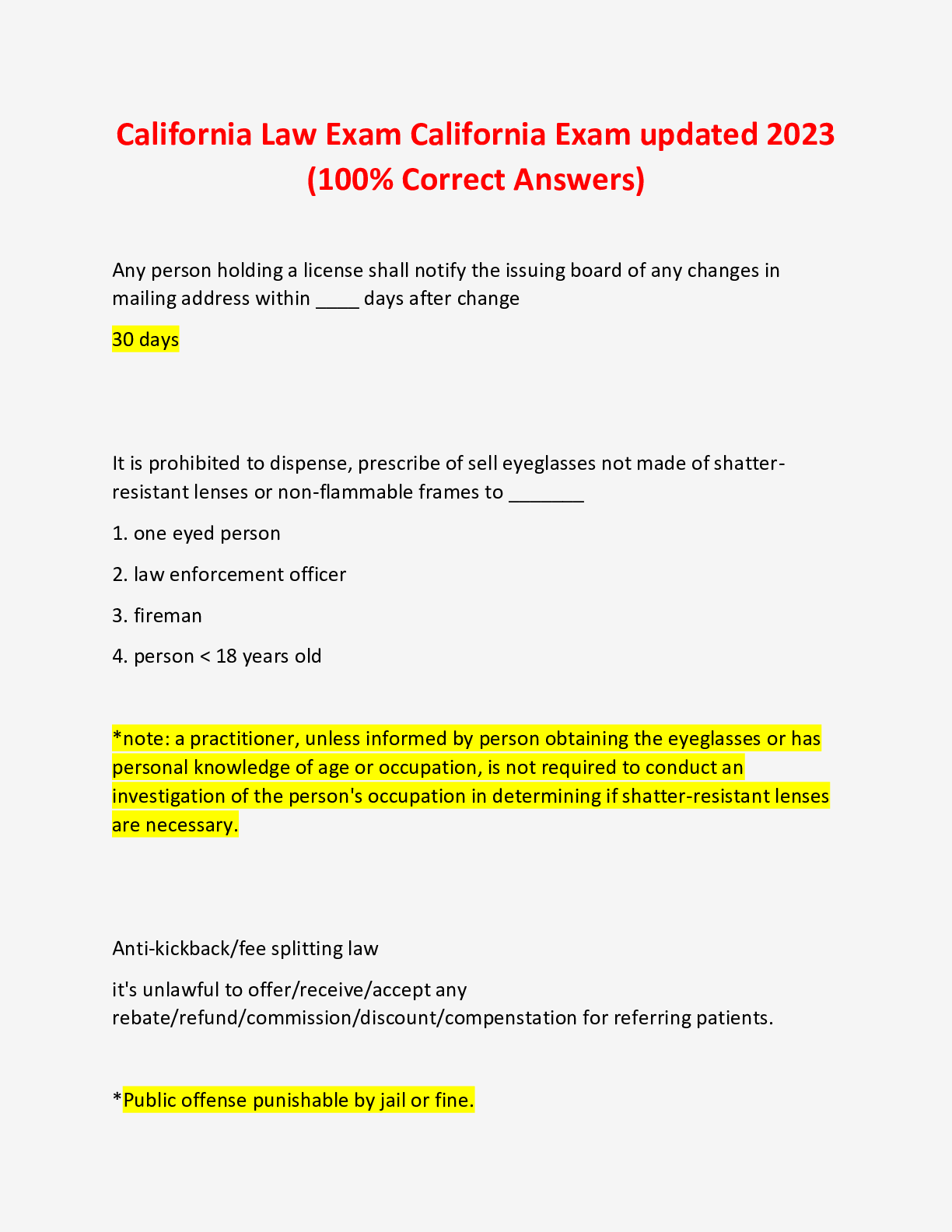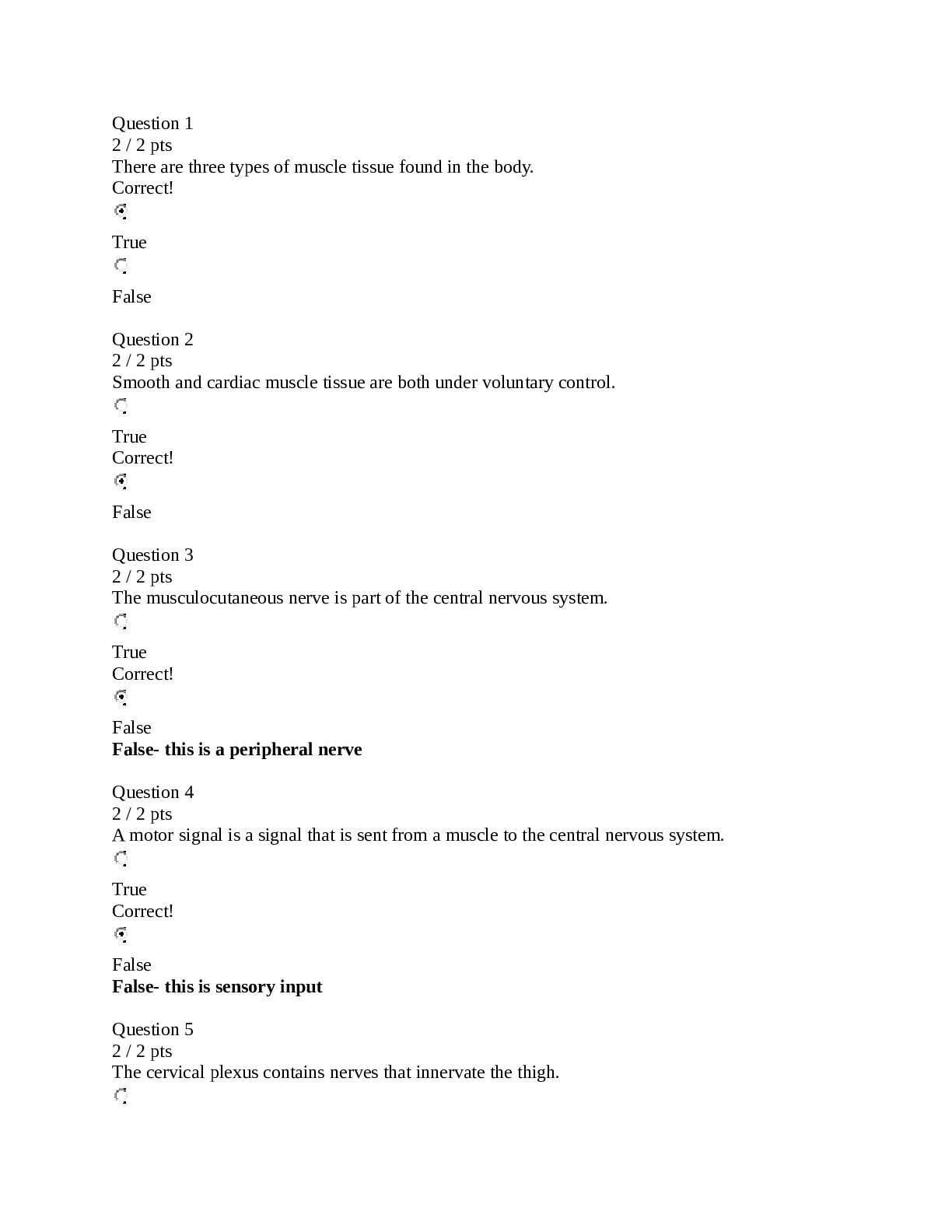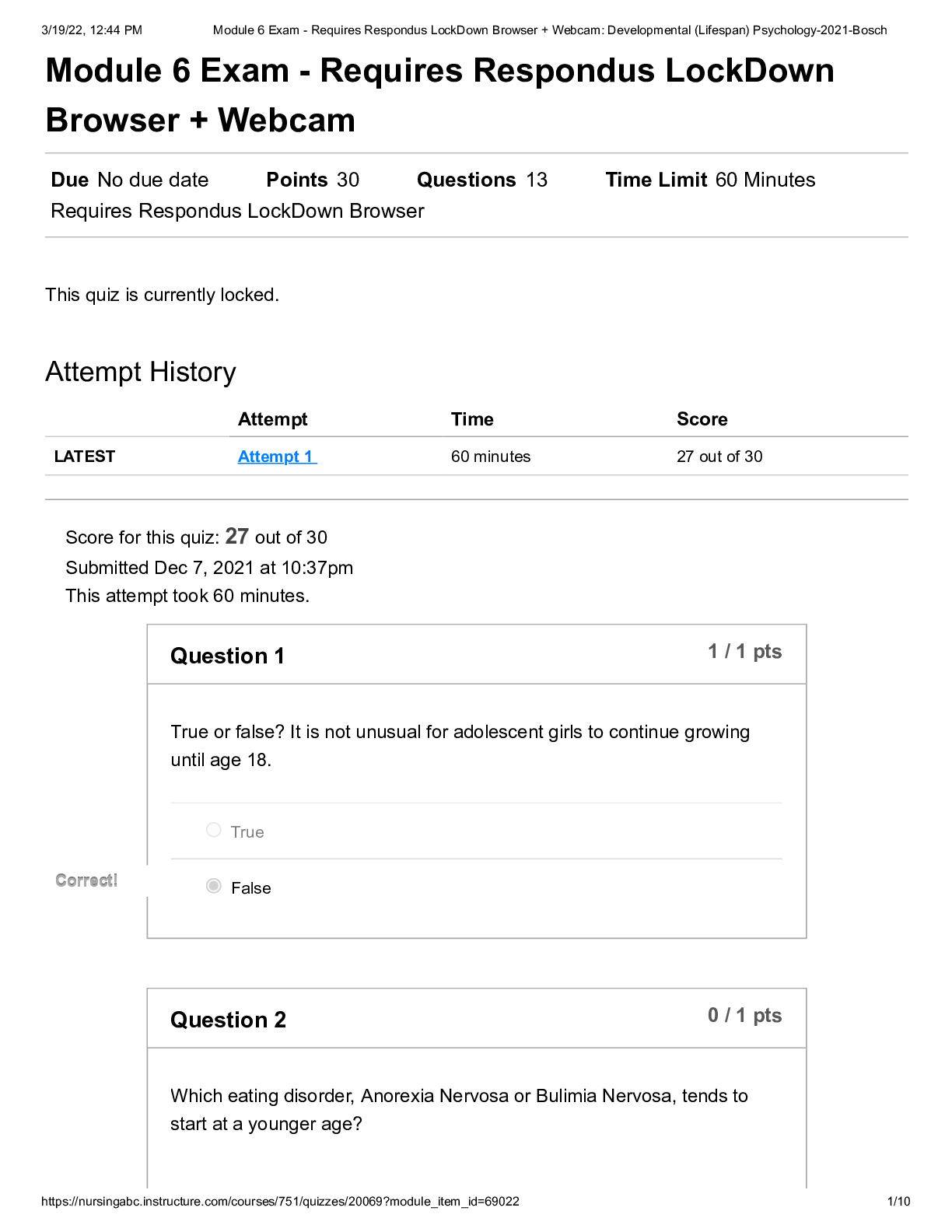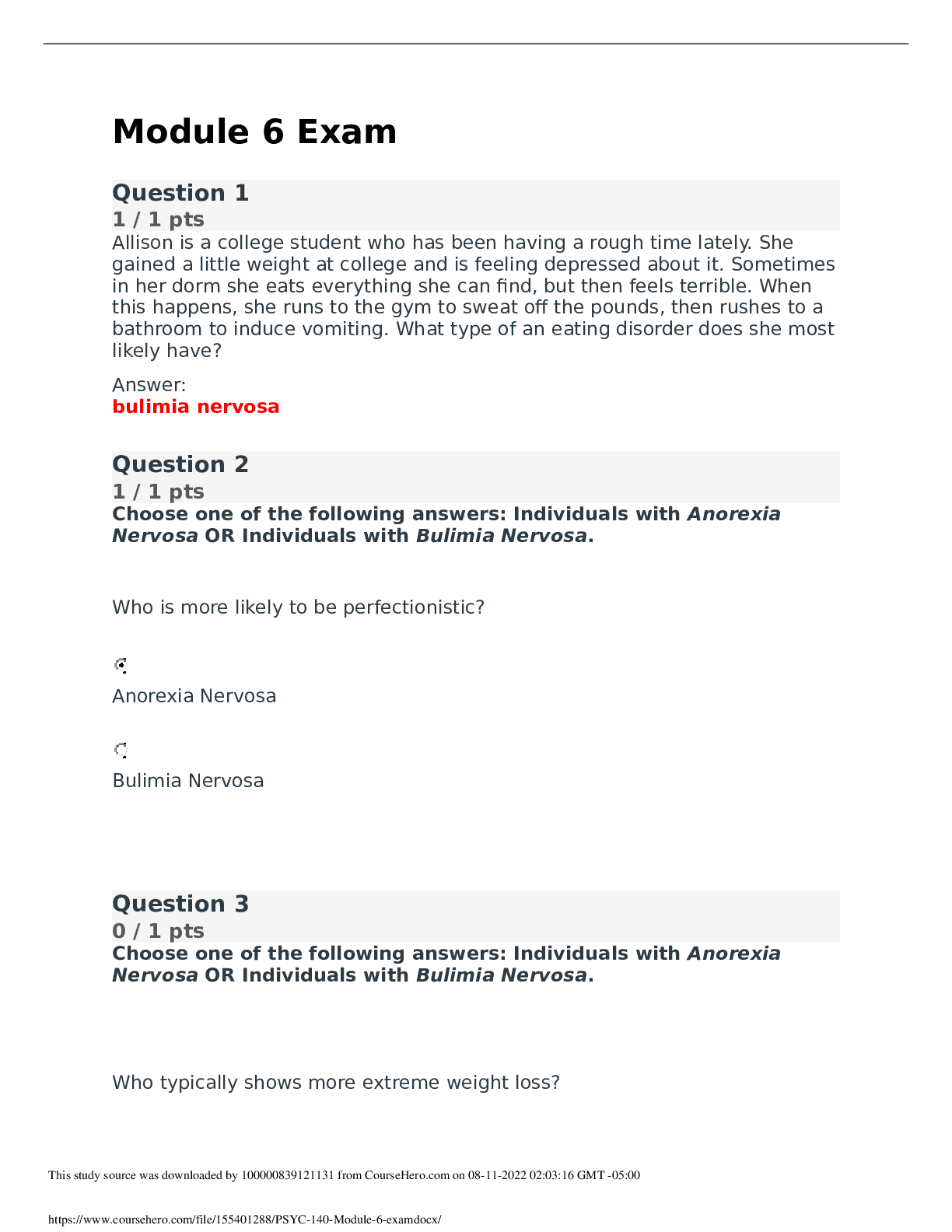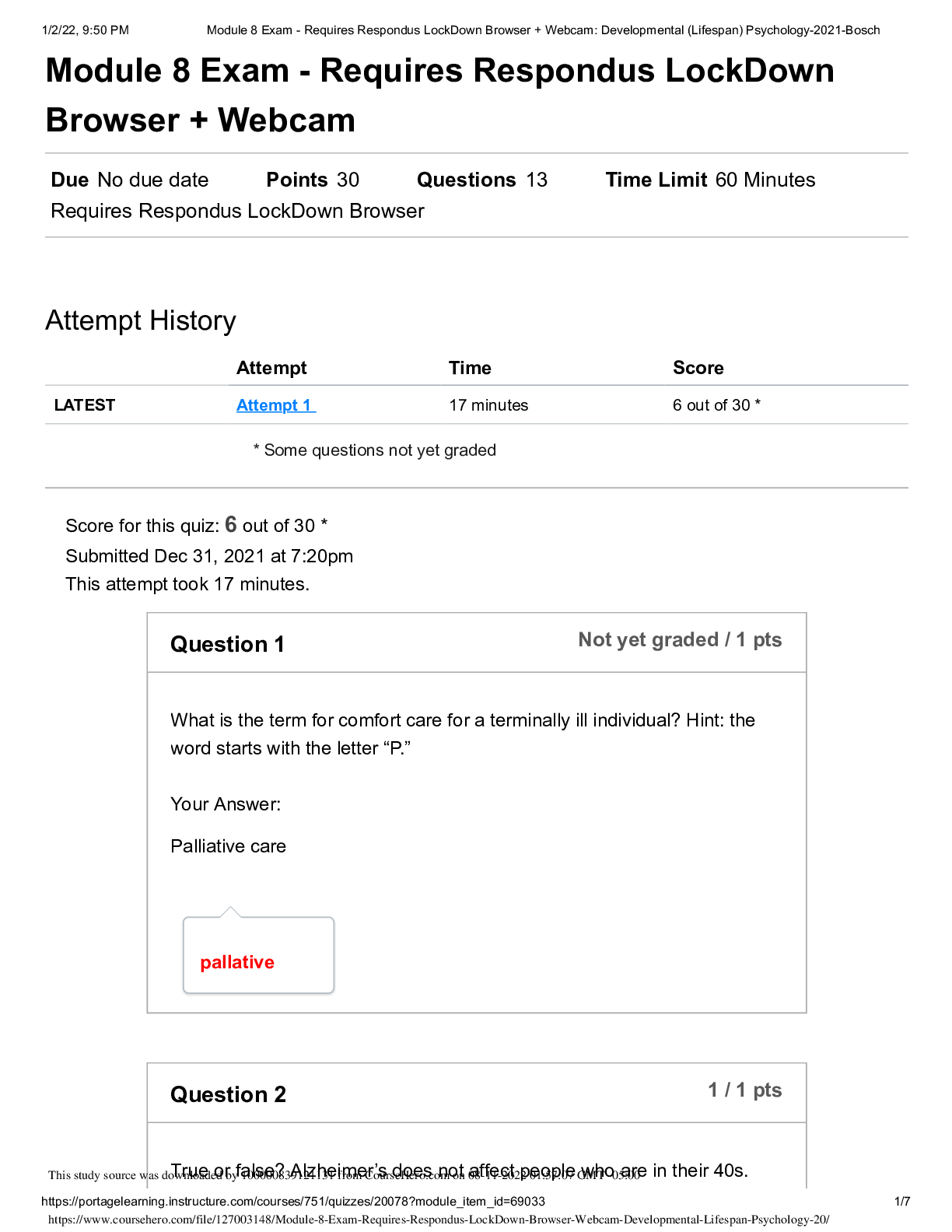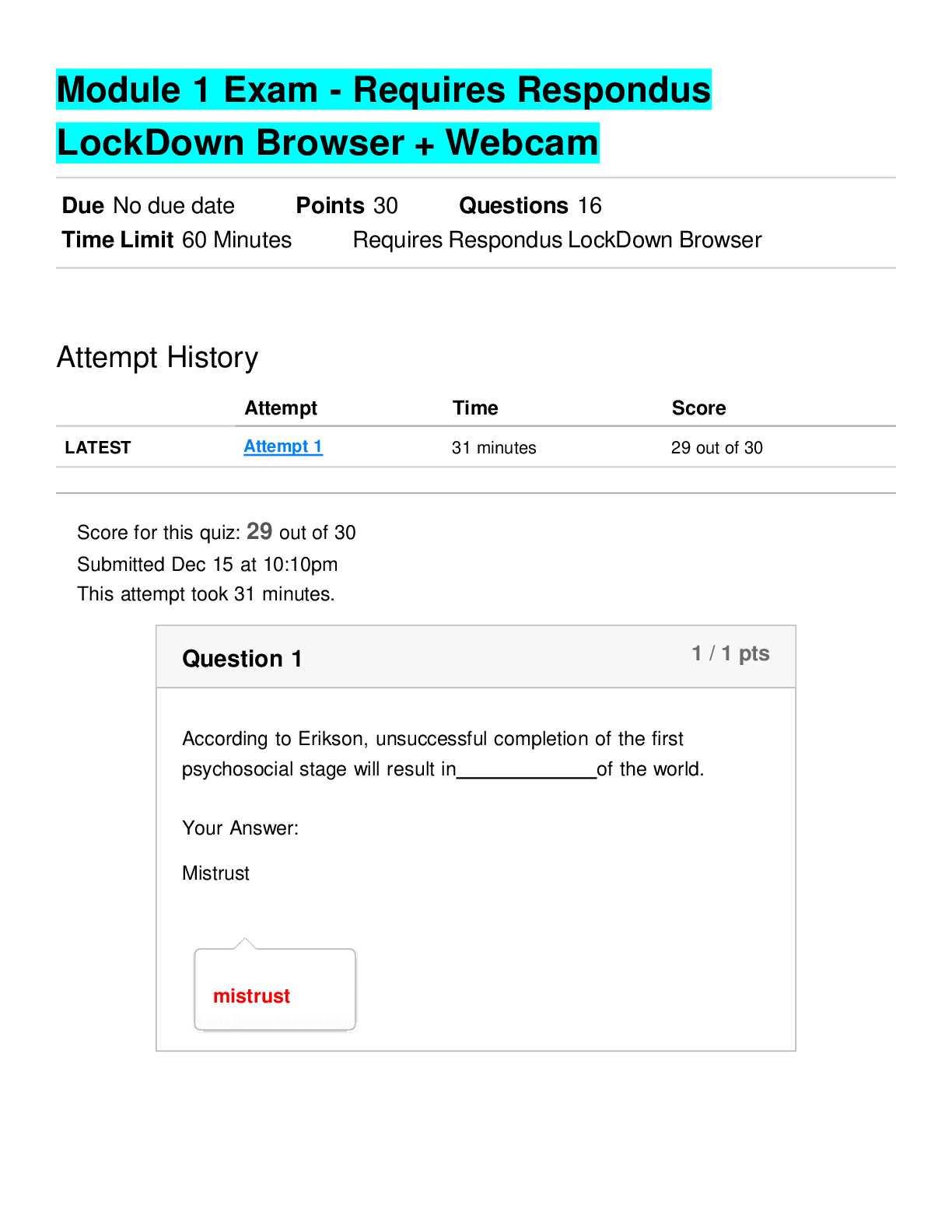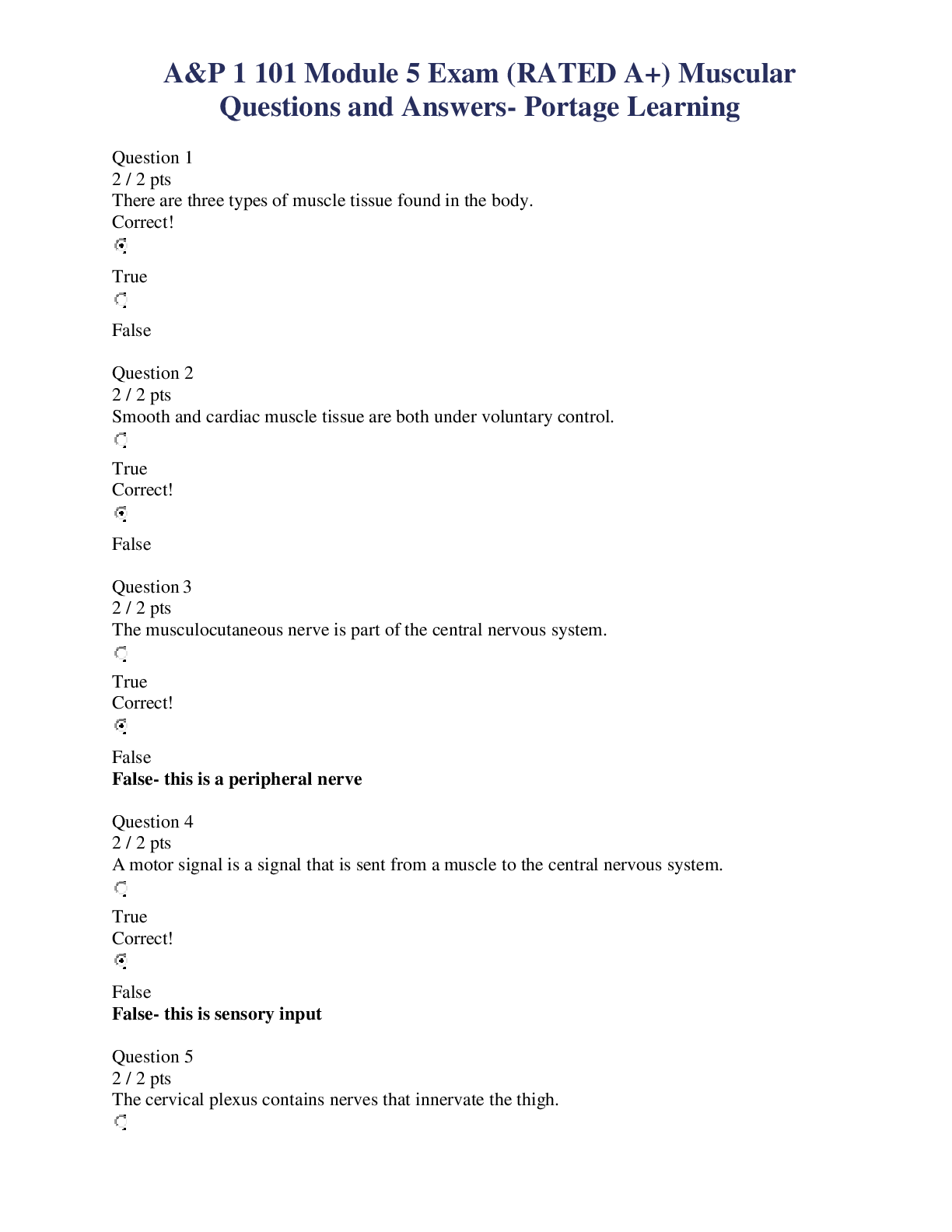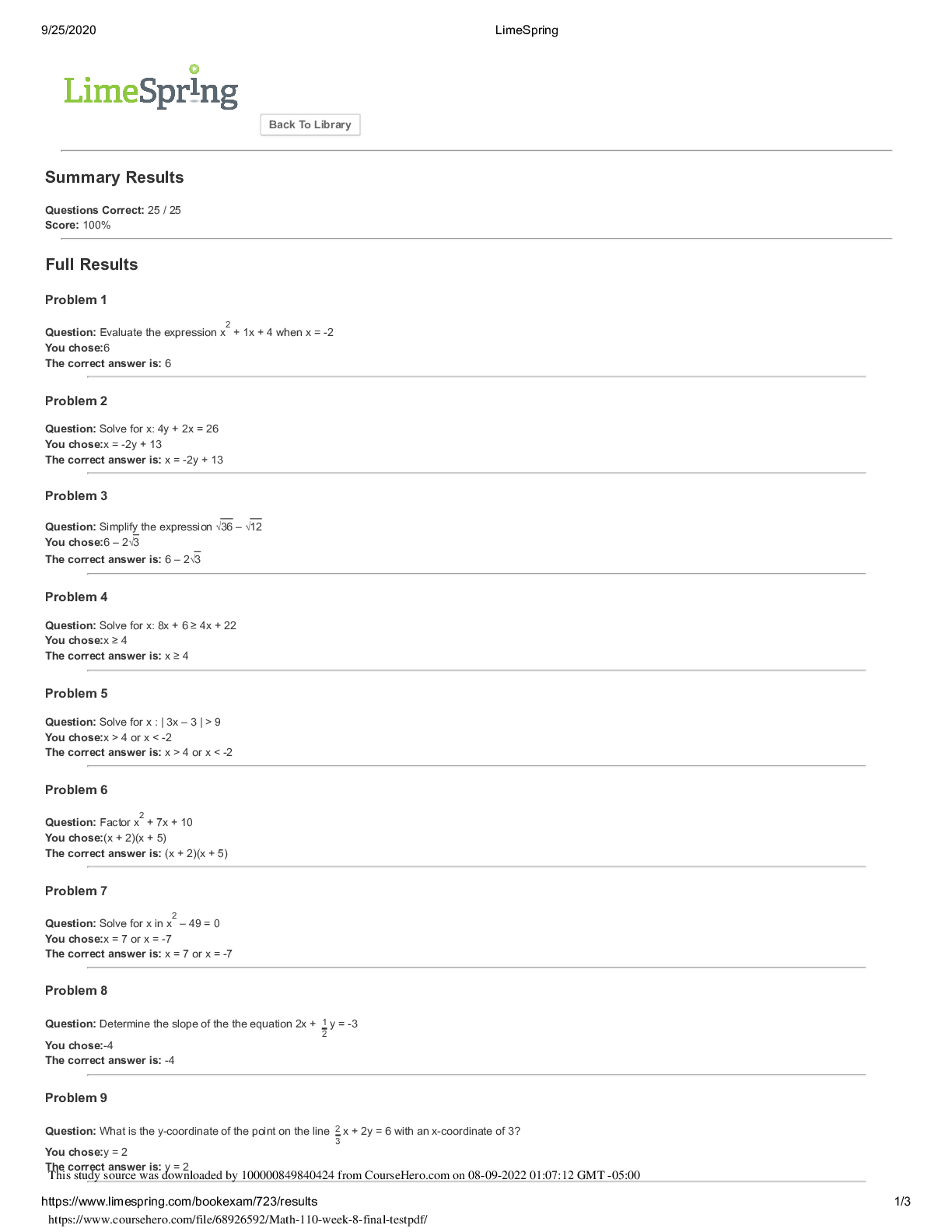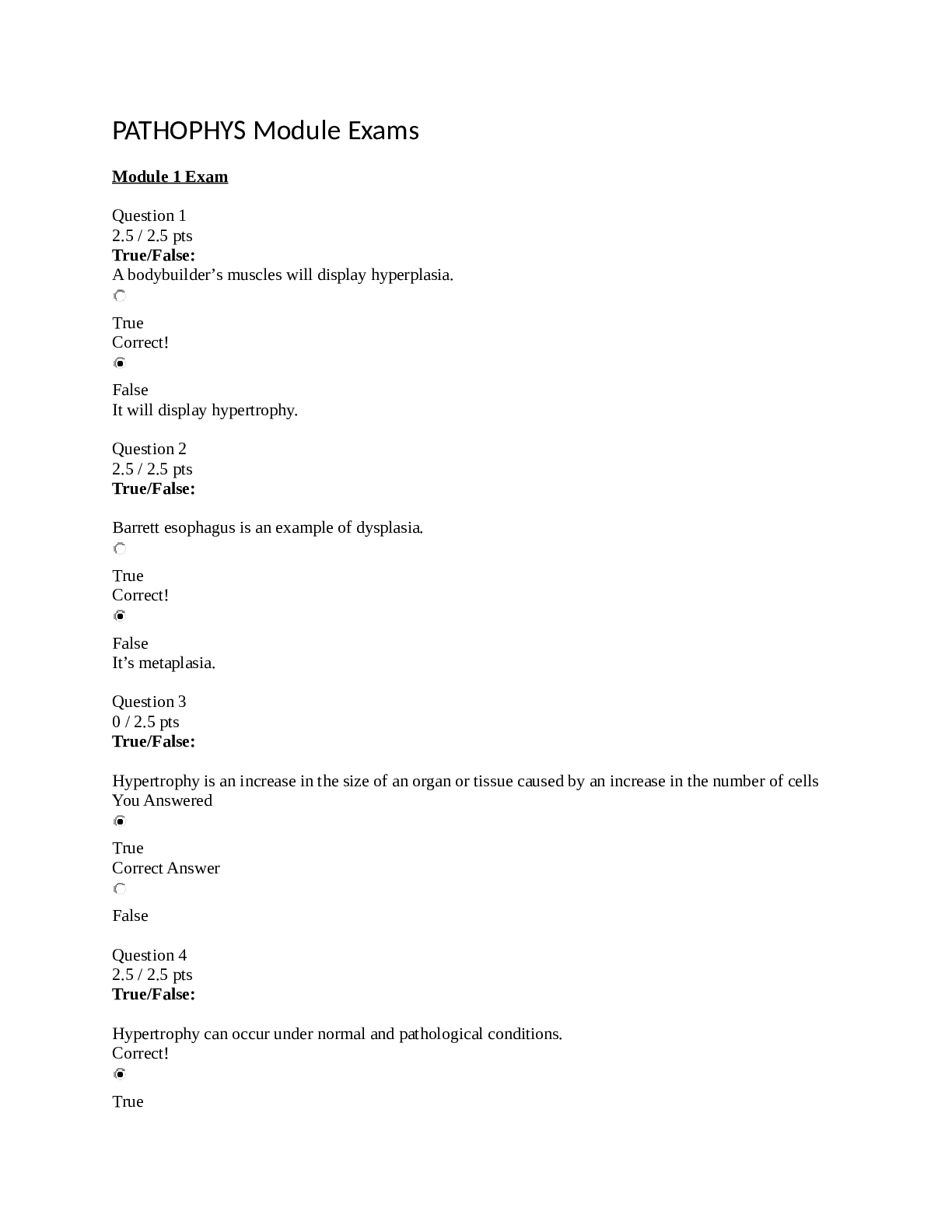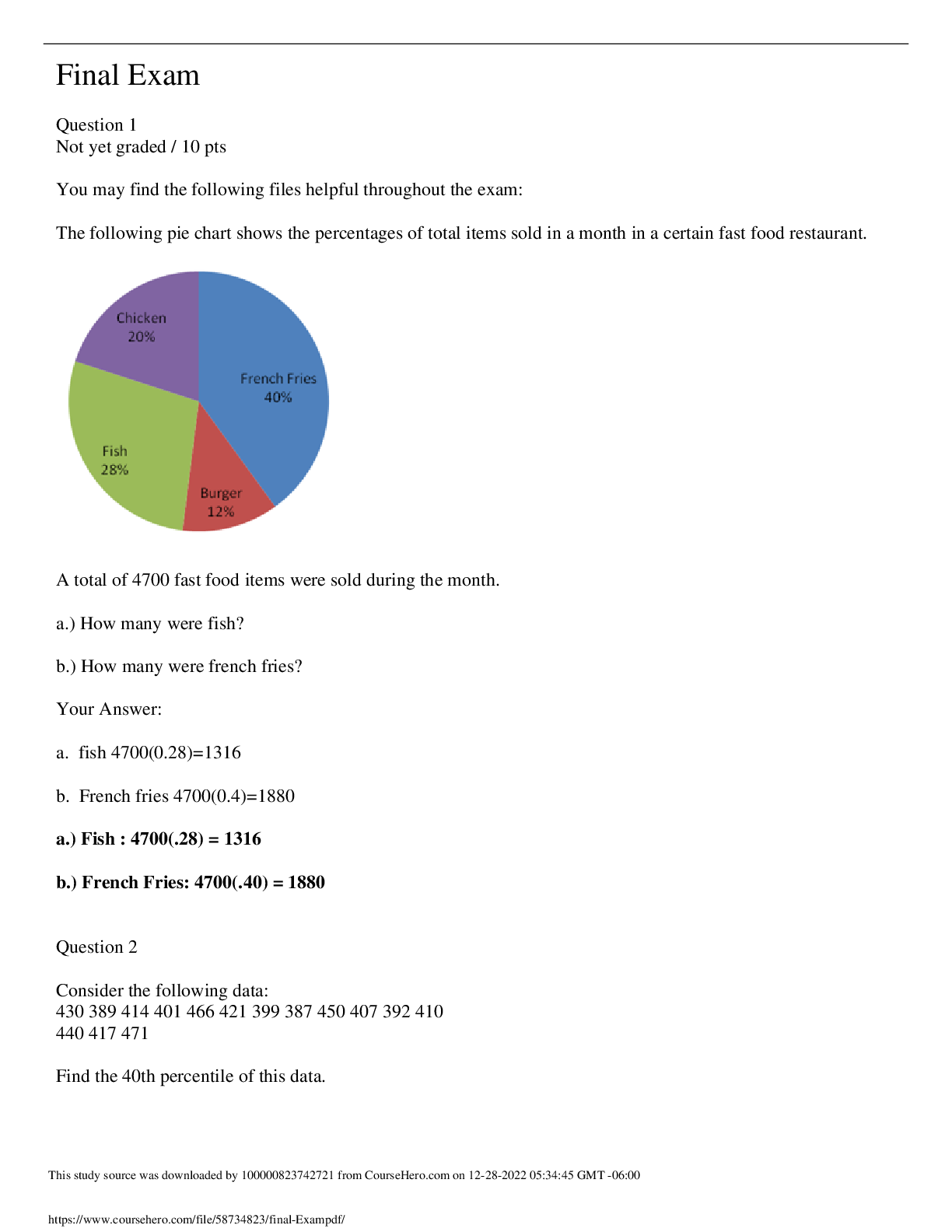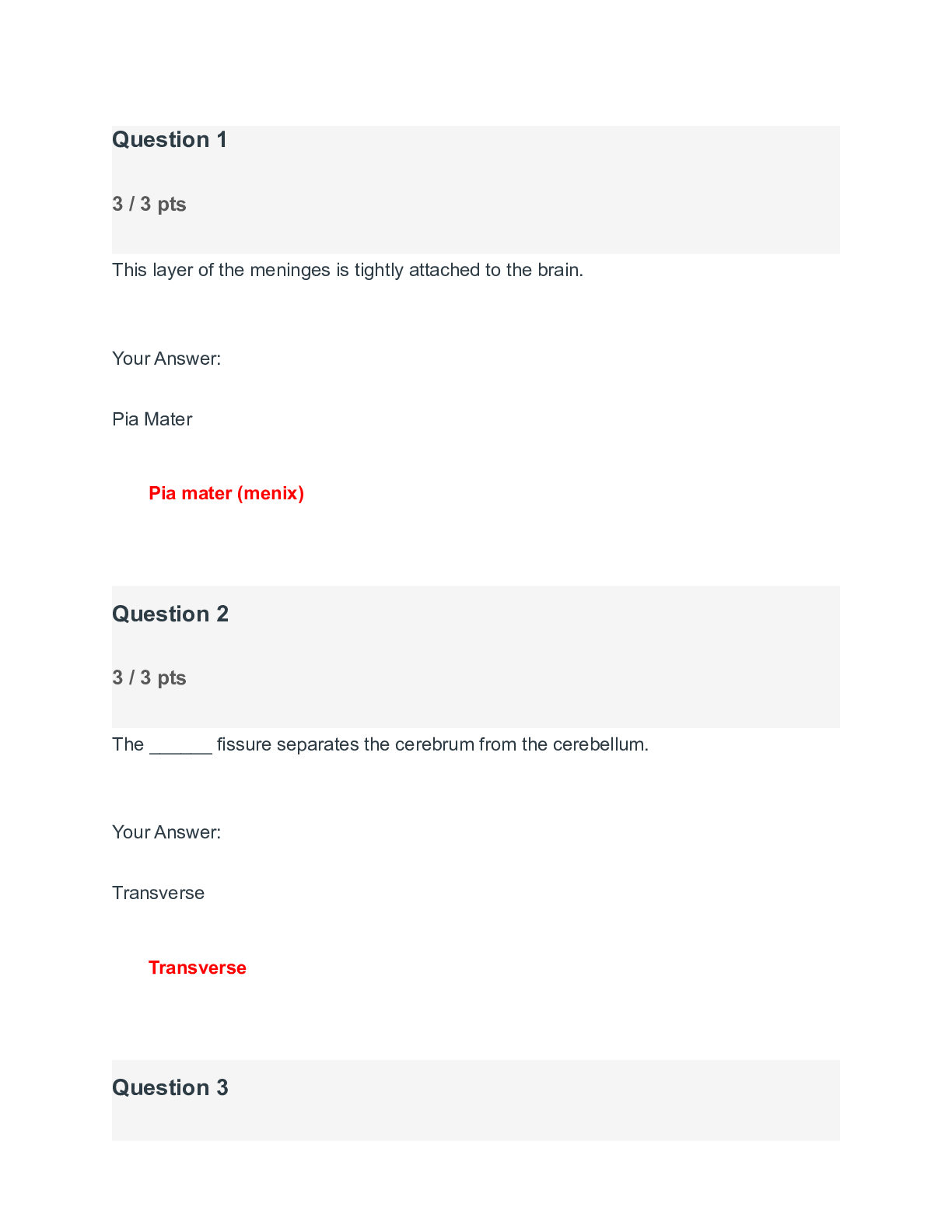Biology > EXAM > A&P 1 101 Module 5 Exam Muscular (GRADED A+) Questions and Answers- Portage Learning (All)
A&P 1 101 Module 5 Exam Muscular (GRADED A+) Questions and Answers- Portage Learning
Document Content and Description Below
A&P 1 101 Module 5 Exam Muscular (GRADED A+) Questions and Answers Question 1 2 / 2 pts There are three types of muscle tissue found in the body. Correct! True False Question 2 2 / 2 pts S... mooth and cardiac muscle tissue are both under voluntary control. True Correct! False Question 3 2 / 2 pts The musculocutaneous nerve is part of the central nervous system. True Correct! False False- this is a peripheral nerve Question 4 2 / 2 pts A motor signal is a signal that is sent from a muscle to the central nervous system. True Correct! False False- this is sensory input Question 5 2 / 2 pts The cervical plexus contains nerves that innervate the thigh. True Correct! False Question 6 2 / 2 pts Answer the following short-answer question: Ligaments connect which types of tissue? Your Answer: It connects bone to bone Connect bone to bone Question 7 2 / 2 pts Answer the following short-answer question: Acetylcholine is what type of substance? Your Answer: It is a neurotransmitter Neurotransmitter Question 8 2 / 2 pts Answer the following short-answer question: During a muscle contraction which protein myofilament is pulled along? Your Answer: Actin Actin Question 9 2 / 2 pts Answer the following short-answer questions: What is the name of the thick myofilament? Your Answer: Mayosin Myosin Question 10 2 / 2 pts Answer the following short-answer question: What must occur for a muscle contraction to stop? Your Answer: Usually stops when the nerve impulses no longer stimulates the muscle fiber. Calcium ions are pumped back into the saroplasmic reticulum by active transport. Calcium ions must be pumped back into the sarcoplasmic reticulum Question 11 10 / 10 pts Label the following five muscles: A: D: F: H: I: Your Answer: A-Frontalis D-Orbicularis oculi F-Zygomaticus minor H-Risorius I-masseter A: Frontalis/ occipitofrontalis D: Orbicularis Oris F: Zygomaticus minor H: Risorius I: Masseter Question 12 10 / 10 pts Fill in the following muscle chart (10 blank spaces): Muscle Origin Insertion Action Innervation Flexor digitorum superficialis ------- ---------- 1. 2. Pronator Teres ------- 3. 4. 5. Vastus Medialis 6. ---------- 7. -------------- Peroneus Brevis 8. 9. ----------- 10. 1. [answer1] 2. [answer2] 3. [answer3] 4. [answer4] 5. [answer5] 6. [answer6] 7. [answer7] 8. [answer8] 9. [answer9] 10. [answer10] Your Answer: 1- flexion of the wrist and digits 205 2-Median nerve 3-Mid lateral surface ofradius 4-pronation 5-median nerve 6 intertrochanteric line of femur 7 knee extension 8 lateral, distal fibula 9 lateral side of the 5th metatarsal 10 superficial peroneal nerve 1. Flexion of the wrist and digits 2-5 2. Median nerve 3. Mid-lateral surface of radius 4. Pronation 5. Median nerve 6. Intertrochanteric line of femur 7. Knee extension 8. Lateral, distal fibula 9. Lateral side of 5th metatarsal 10. Superficial peroneal nerve Question 13 2 / 2 pts Your patient sustained an injury to their facial nerve (CN VII). Which actions would be impaired? A. Extend head/neck B. Compress cheeks C. Grin/grimace D. Elevate mandible E. A&D Correct! F. B&C F.B &C (Buccinator & risorius) Question 14 2 / 2 pts Your patient is having difficulty when asked to bring his chin to his chest. He is also having difficulty turning his face from side to side. What muscle is most likely impaired? Thyrohyoid Semispinalis capitis Splenius Capitis Correct! Sternocleidomastoid (Bilateral neck flexion, unilateral turns face) Scalenes Question 15 2 / 2 pts A person sustained a back injury to the muscle group closest to the spine. What muscle group was injured? Longissimus Correct! Spinalis Sternocleidomastoid Iliocostalis Rectus abdominis Question 16 0 / 2 pts True or False: When a muscle contracts, the M lines within a sarcomere come closer together towards the Z line. You Answered True Correct Answer False Question 17 2 / 2 pts True or False: The A band contains thin filaments. Correct! True (A band contains thick filaments and thin filaments) False Question 18 2 / 2 pts Which muscle contracts to enable the main effort required to stand on your toes? Correct! Gastrocnemius Quadriceps Biceps femoris Tibialis anterior Question 19 2 / 2 pts When rectus femoris contracts, which bone is pulled anteriorly by this muscle? Femur Correct! Tibia Ilium Ulna Question 20 2 / 2 pts When extensor digitorum contracts, what action(s) occurs? A. Elbow extension B. Wrist extension C. Extension of digit 1 D. Extension of digits 2-5 E. A&C Correct! F. B&D Question 21 2 / 2 pts Contraction of results in ? Correct! psoas major, hip flexion psoas major, hip extension iliacus, trunk flexion iliacus, trunk extension Question 22 2 / 2 pts When superior gemellus contracts, what action(s) will not occur at the hip? A. Lateral rotation B. Internal rotation C. Adduction D. Extension E. Flexion F. A&D Correct! G. B&E Question 23 10 / 10 pts Use the figure answer the following five questions: 1. Which muscle has origins on both the clavicle and scapula? (specify letter on diagram with the name of the muscle for full credit) 2. Which muscle is innervated by the thoracodorsal nerve? (specify letter on diagram with the name of the muscle for full credit) 3. What is the name of muscle D? 4. What is the innervation of muscle D? 5. What is the insertion of muscle E? Your Answer: 1-A - Deltoid muscle 2- H- Latissimus Dorsi 3-Infraspinatus 4- Suprascapular nerve 5- Greater tubercle of humerus 1. A (Deltoid) 2. H or I (Lats) 3. Infraspinatus 4. Suprascapular nerve 5. Intertubercular groove of humerus (Teres major) Question 24 10 / 10 pts Use the figure to label the following six muscles: (Viewed anteriorly) A: B: C: D: E: F: Your Answer: A-Flexor carpi radialis B - flexor digitorum superficialis C - palmaris longus D - flexor carpi ulnaris E- flexor pollicis longus F - flexor digitorum profundus A: Flexor carpi radialis B: Flexor digitorum superficialis C: Palmaris longus D: Flexor Carpi Ulnaris E: Flexor pollicis longus F: Flexor digitorum profundus Question 25 10 / 10 pts Use the figure to label the following six muscles: D: E: F: G: H: I: Your Answer: D-preneus longus E-soleus F-Tibialis posterior G-flexor digitorum longus H-flexor hallucis longus I-peroneus brevis D: Peroneus (fibularis) longus E: Soleus F: Tibialis posterior G: Flexor digitorum longus H: Flexor hallucis longus I: Peroneus (fibularis) brevis Question 26 10 / 10 pts Answer the following essay question: Describe what is meant by muscle fiber “cross-bridges”. What occurs to enable movement of the cross-bridges? Your Answer: cross bridges occur when calcium ions are present and this causes portions of the myosin filaments to bend backwards and attach to actin filaments. After that, the cross bridges bend forward and the actin filaments is pulled along. After that, the cross bridges attach and detach 50- 100 times as the thin filaments are pulled to the center of sarcomere. ADP is needed for myosin cross bridges to pull the actin filaments. In the presence of calcium ions, portions of a myosin filament called cross-bridges bend backward and attach to an actin filament. After attaching to the actin filament, the cross- bridges bend forward, and the actin filament is pulled along. The cross-bridges attach and detach some fifty to 100 times as the thin filaments are pulled to the center of a sarcomere. ATP is needed on a cellular level for the myosin to pull actin along. [Show More]
Last updated: 1 year ago
Preview 1 out of 16 pages
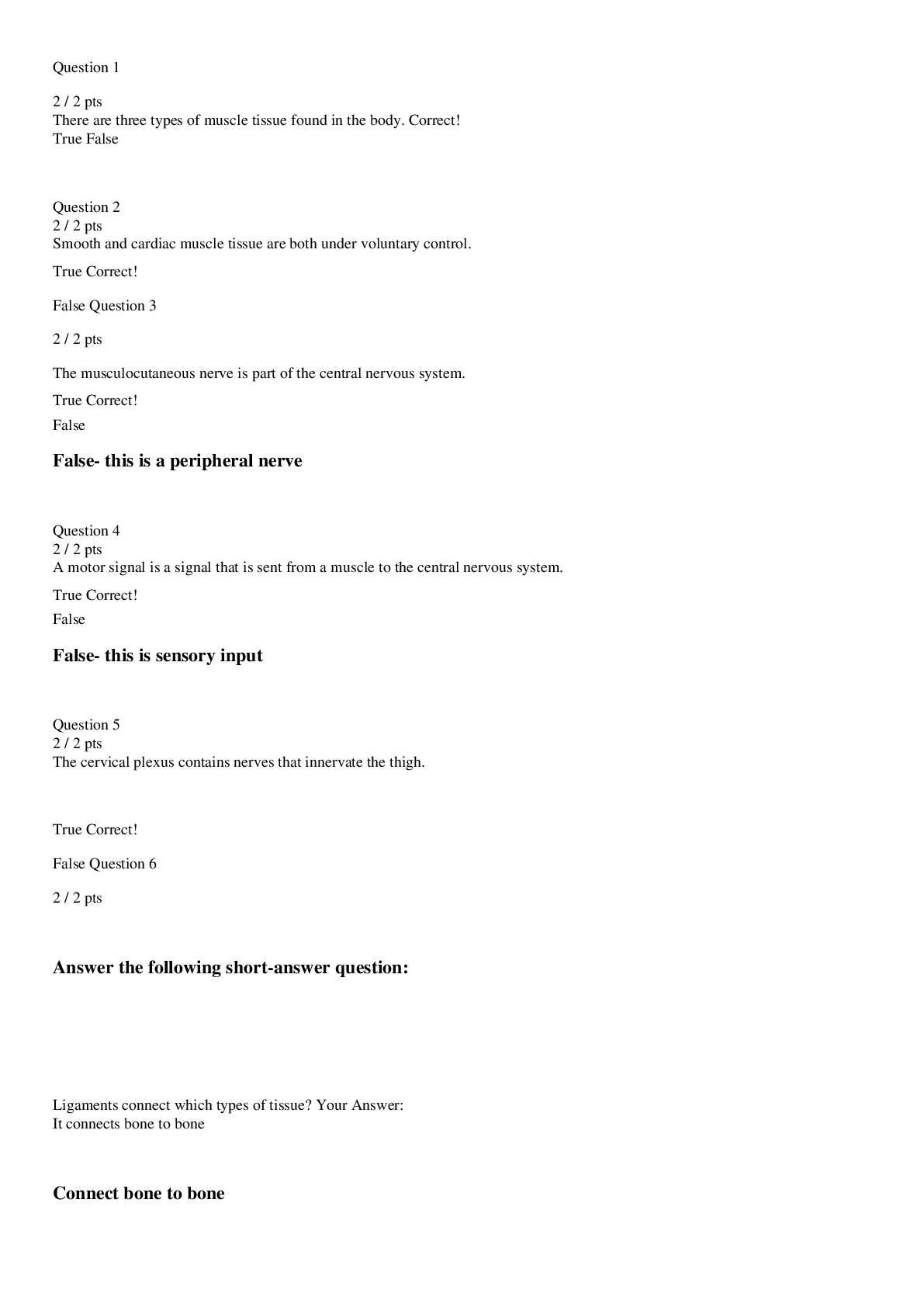
Also available in bundle (1)
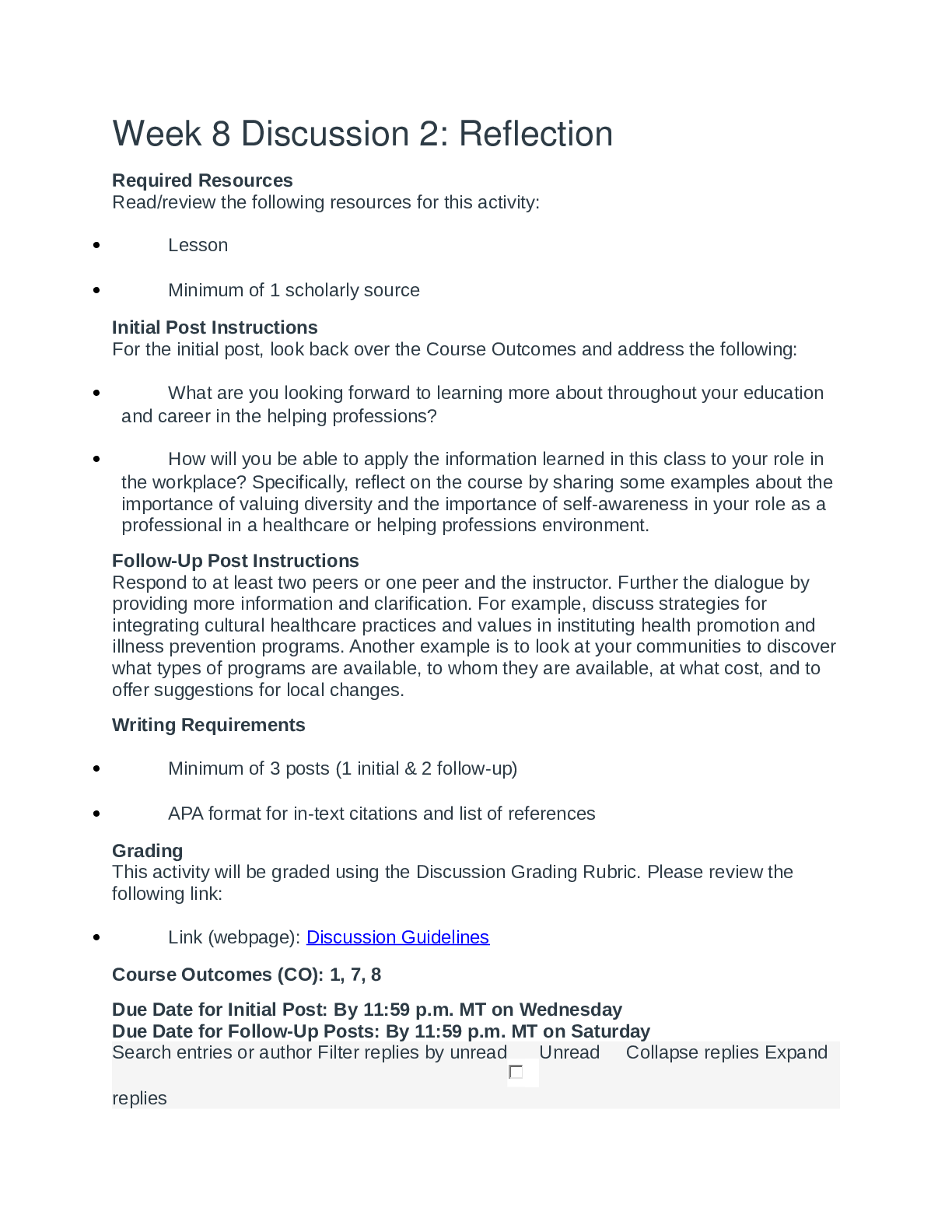
A&P 1 101 Module 1-8 Exam BUNDLE (GRADED A+) Comprehensive set Portage Learning 2021
A&P 1 101 Module 1-8 Exam BUNDLE (GRADED A+) Comprehensive set Portage Learning 2021
By A+ Solutions 2 years ago
$13.5
23
Reviews( 0 )
Document information
Connected school, study & course
About the document
Uploaded On
Aug 19, 2021
Number of pages
16
Written in
Additional information
This document has been written for:
Uploaded
Aug 19, 2021
Downloads
0
Views
102

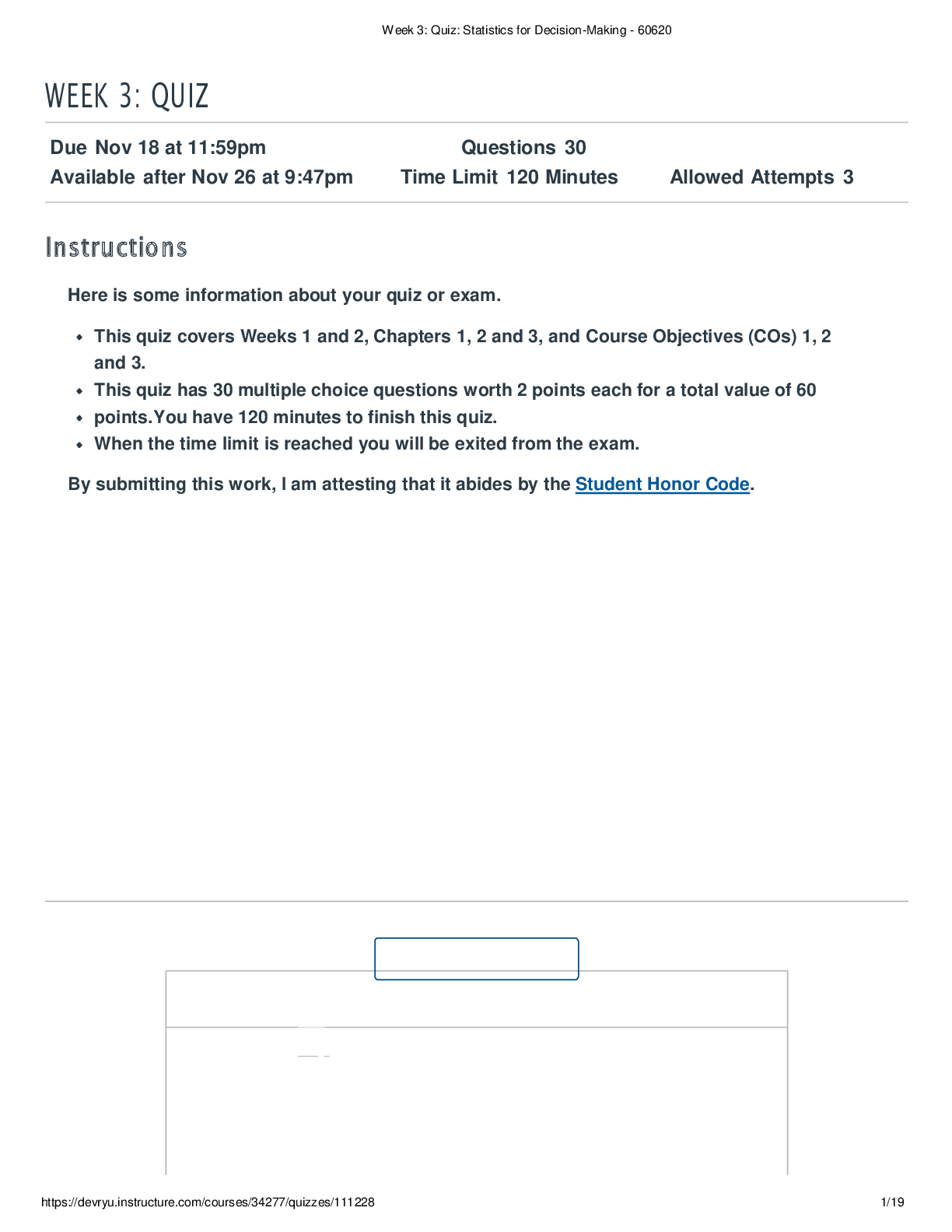

.png)










